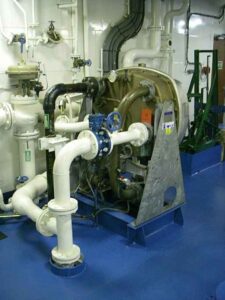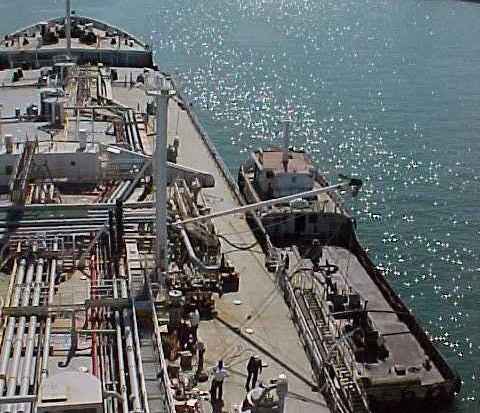Ships require fresh water for various operations, but seawater is not a viable source due to its high salinity. That’s why modern ships are fitted with sophisticated freshwater generators or desalination plants, which work tirelessly to transform salty seawater into life-giving freshwater. In this article, we will discuss its components, the process and types of freshwater generators.
COMPONENTS OF A FRESHWATER GENERATOR
A freshwater generator has four main components:
- Shell.The shell is the outer casing that encloses the other components and provides insulation.
- Condense. The condenser is a heat exchanger that cools down the hot vapour produced by the evaporator and condenses it into liquid water.
- Evaporator. The evaporator is a chamber where seawater is heated by steam or hot water and evaporated into vapour.
- Demister. The demister is used to separate the liquid and vapor phases of the seawater.
Other components of a freshwater generator include:
- Ejector. An ejector is a device that uses steam or seawater as the driving fluid to create a vacuum in the evaporator. The ejector also helps to extract the gases that do not condense from the evaporator.
- Fresh water pump. The function of this pump is to transport fresh water from the condenser to either the storage tank or distribution system. Additionally, it ensures that the condenser maintains a positive pressure, which serves to prevent any possible contamination from seawater.
- Safety relief valve. A safety relief valve is in place to safeguard both the evaporator and the condenser against excessive pressure. Whenever the pressure surpasses a predetermined level, the safety relief valve is triggered and discharges the steam or seawater either to the atmosphere or the drain.
- Air purge. The air purge system is designed to eliminate air and non-condensable gases from both the evaporator and condenser on a regular basis. By doing so, it enhances the freshwater generator’s efficiency and overall performance by minimizing heat transfer resistance.
THE PROCESS OF SALTWATER DESALINATION
The process of saltwater desalination can be broken down into the following steps:
- Pumping seawater into the freshwater generator through a connection to the sea.
- Cooling the seawater in the condenser.
- Heating the seawater in the evaporator using a heat source such as a steam boiler or waste heat recovery system.
- Evaporating some of the seawater as it is heated, causing it to rise to the top of the evaporator.
- Condensing the evaporated seawater and allowing it to drip down to the demister.
- Separating the liquid and vapor phases of the seawater in the demister.
- Drawing out the fresh water from the generator using the fresh water pump.
- Discharging the remaining seawater back into the sea.
TYPES OF FRESHWATER GENERATORS
There are two main types of freshwater generators:
- Low-pressure flash evaporators. This is the most common type and usually used by merchant vessels and offshore platforms. By using a combination of heat and vacuum, low-pressure flash evaporators convert seawater into vapor, which is subsequently condensed to produce freshwater.
- High-pressure reverse osmosis systems. High-pressure reverse osmosis systems use pumps and membranes to compel seawater to pass through a filter that effectively eliminates salt and other contaminants. This type of freshwater generators is more energy-efficient and are used in large-scale desalination plants.
Freshwater generators are one of the most important machineries onboard. Without a reliable freshwater generator, ships would be forced to rely on limited supplies of freshwater, which could quickly become depleted on long voyages. This could result in a range of problems, including dehydration, poor hygiene, and potential health risks.




